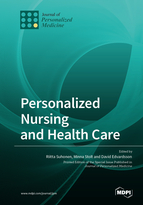Personalized Nursing and Health Care
A special issue of Journal of Personalized Medicine (ISSN 2075-4426).
Deadline for manuscript submissions: closed (5 December 2021) | Viewed by 62477
Special Issue Editors
Interests: gerontological nursing; older people nursing care; individualized care; management; ethics; self-management of older people; care environment
Interests: nursing research and evidence-based practice; nursing care; nursing; podiatry; older adults; functional ability; foot deformities; nursing research
2. College of Science, Health and Engineering, La Trobe University, Melbourne, VIC 3086, Australia
Interests: nursing; clinical nursing; nursing education; advanced practice nursing; nursing leadership; nursing ethics; nursing assessment; nursing management; nursing theory; critical care nursing
Special Issue Information
Dear Colleagues,
There has been a rapid development in the academic literature over the last ten years on papers relating to individualization, personalization, patient-, client-, consumer- and person-centredness, with work on conceptual, instrumental, observational and experimental levels. This Special Issue invites papers that can further establish the current state of science on these topics relating to personalized nursing and health care. Papers are welcome that highlight and further the knowledge base conceptually, instrumentally, observationally and experimentally, with sound theoretical and methodological underpinnings and implications for research, theory and clinical work in the disciplines of nursing, medicine, allied health and beyond.
Prof. Dr. Riitta Suhonen
Dr. Minna Stolt
Prof. Dr. David Edvardsson
Guest Editors
Manuscript Submission Information
Manuscripts should be submitted online at www.mdpi.com by registering and logging in to this website. Once you are registered, click here to go to the submission form. Manuscripts can be submitted until the deadline. All submissions that pass pre-check are peer-reviewed. Accepted papers will be published continuously in the journal (as soon as accepted) and will be listed together on the special issue website. Research articles, review articles as well as short communications are invited. For planned papers, a title and short abstract (about 100 words) can be sent to the Editorial Office for announcement on this website.
Submitted manuscripts should not have been published previously, nor be under consideration for publication elsewhere (except conference proceedings papers). All manuscripts are thoroughly refereed through a single-blind peer-review process. A guide for authors and other relevant information for submission of manuscripts is available on the Instructions for Authors page. Journal of Personalized Medicine is an international peer-reviewed open access monthly journal published by MDPI.
Please visit the Instructions for Authors page before submitting a manuscript. The Article Processing Charge (APC) for publication in this open access journal is 2600 CHF (Swiss Francs). Submitted papers should be well formatted and use good English. Authors may use MDPI's English editing service prior to publication or during author revisions.
Keywords
- individualization
- personalization
- patient-centredness
- client-centredness
- consumer-centredness
- person-centredness









